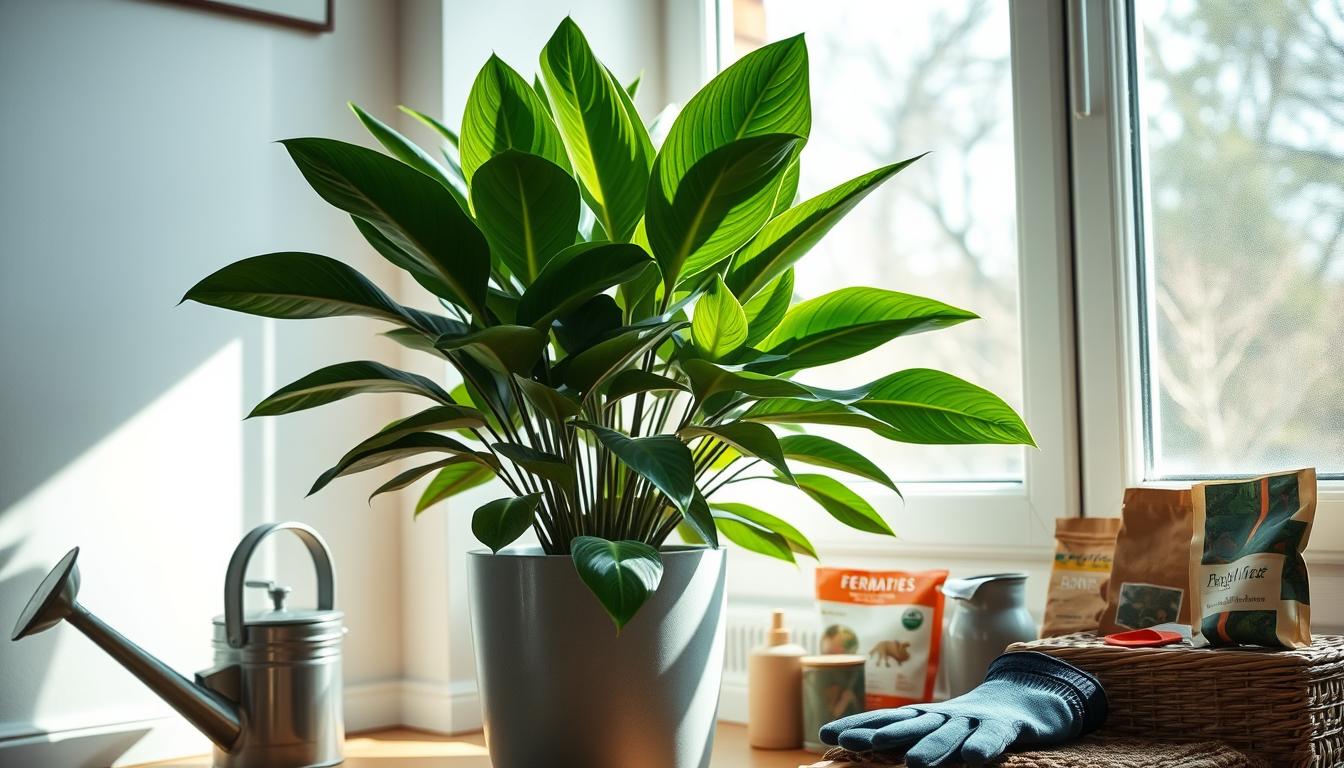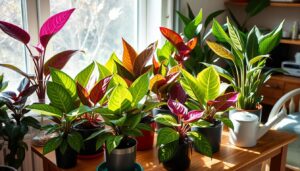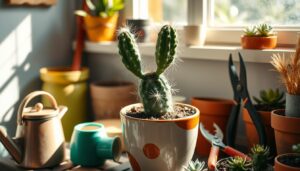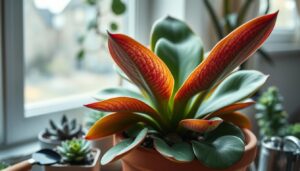As a low-maintenance indoor plant enthusiast, you’re likely familiar with the Aspidistra, commonly known as the Cast Iron Plant. This plant is renowned for its resilience and ability to thrive in a variety of conditions, making it perfect for beginners and seasoned plant enthusiasts alike. With proper Aspidistra care, you can create a beautiful and thriving indoor space.
When it comes to Aspidistra care, understanding the plant’s needs is crucial. The Cast Iron Plant is a low-maintenance indoor plant that can tolerate a range of lighting conditions, making it an excellent choice for rooms with limited natural light. By following the right Aspidistra care tips, you can help your plant flourish and enjoy its elegant, dark green leaves.
Whether you’re a seasoned plant parent or just starting out, Aspidistra care is relatively straightforward. With the right balance of light, water, and temperature, you can keep your Cast Iron Plant happy and healthy. In this guide, we’ll cover the essentials of Aspidistra care, including tips on how to create the perfect environment for your low-maintenance indoor plant to thrive.
Key Takeaways
- Aspidistra is a low-maintenance indoor plant that can thrive in a variety of conditions
- Proper Aspidistra care involves understanding the plant’s lighting, watering, and temperature needs
- The Cast Iron Plant can tolerate a range of lighting conditions, making it perfect for rooms with limited natural light
- Aspidistra care tips include using well-draining soil and avoiding overwatering
- With the right care, your Aspidistra can become a beautiful and thriving addition to your indoor space
- Aspidistra care is relatively straightforward, making it an excellent choice for beginners and seasoned plant enthusiasts alike
Introduction to Aspidistra: A Resilient Houseplant
Aspidistra is a popular choice for interior decoration due to its elegant, dark green leaves and ability to survive in low-light conditions. Understanding the history of Aspidistra can help you appreciate its unique needs and how to care for it effectively.
When it comes to Aspidistra care indoors, it’s essential to consider the plant’s characteristics, such as its long, lance-shaped leaves that can grow up to 2 feet in length, and its ability to tolerate a wide range of temperatures and humidity levels.
Brief History of the Aspidistra Plant
The history of Aspidistra dates back to the Victorian era, when it was a popular choice for interior decoration. The plant’s ability to thrive in low-light conditions made it an ideal choice for homes with limited natural light.
Characteristics of the Cast Iron Plant
Some key characteristics of the Cast Iron Plant include:
- Long, lance-shaped leaves that can grow up to 2 feet in length
- Ability to tolerate a wide range of temperatures and humidity levels
- Elegant, dark green leaves that add a touch of sophistication to any room
Ideal Growing Conditions for Aspidistra
To ensure your Cast Iron Plant thrives, it’s essential to provide it with the right growing conditions. Aspidistra is known for its adaptability to different light conditions, making it suitable for rooms with low to bright indirect light. When considering best plants for low light, Aspidistra is an excellent choice. Its Cast Iron Plant light requirements are relatively flexible, allowing it to flourish in various environments.
Some key factors to consider when placing your Aspidistra include:
- Avoid direct sunlight, which can cause the leaves to become scorched
- Opt for bright, indirect light for optimal growth
- Maintain a consistent temperature between 65°F to 75°F (18°C to 24°C)
By understanding the ideal growing conditions for your Aspidistra, you can create a perfect spot for it in your home. With its ability to tolerate average humidity levels, Aspidistra is a low-maintenance choice for indoor spaces, making it an excellent option for those looking for best plants for low light conditions.
Light Requirements for Aspidistra
Aspidistra can thrive in a range of light conditions, from low to bright indirect light. This makes it an ideal choice for rooms with limited natural light.
What Temperature is Best for Aspidistra?
The ideal temperature range for Aspidistra is between 65°F to 75°F (18°C to 24°C), making it suitable for most indoor environments.
Humidity Preferences of Aspidistra
Aspidistra can tolerate average humidity levels, making it a low-maintenance choice for indoor spaces. This means you don’t need to worry about maintaining a specific humidity level for your plant to thrive.
Soil and Potting Mix for Aspidistra
When it comes to nurturing your Aspidistra, the right soil and potting mix are crucial for its health. Aspidistra elatior watering requires a well-draining potting mix to prevent waterlogged soil, which can lead to root rot. The soil requirements for Aspidistra include a slightly acidic to neutral soil pH, ranging from 6.1 to 7.0.
Best Soil Types for Aspidistra
The best soil types for Aspidistra are those that are rich in organic matter and have good drainage. Some examples include:
- Potting mixes specifically designed for tropical plants
- Soil with a mix of peat moss, perlite, and vermiculite
- Organic potting soils with added fertilizers
Importance of Drainage in Potting Mix
Drainage is essential in potting mix to prevent waterlogged soil. Aspidistra can tolerate some drought, but overwatering can be detrimental to its health. A well-draining potting mix will help prevent root rot and ensure your Aspidistra receives the right amount of moisture.
Watering Your Aspidistra: Tips and Techniques
Aspidistra elatior watering tips are essential for the plant’s survival. Watering is a crucial aspect of Aspidistra care, and it requires a balanced approach. The frequency of watering depends on the humidity and temperature of your environment. Generally, watering once a week is sufficient, but this may vary.
Understanding the Watering Frequency
To determine the best watering schedule for your Aspidistra, check the soil moisture by sticking your finger into the soil up to the first knuckle. If the soil feels dry, it’s time to water. This low-maintenance watering technique will help you avoid overwatering, which can lead to root rot.
Signs of Overwatering and Underwatering
Recognizing the signs of overwatering and underwatering is crucial to adjust your watering schedule accordingly. Overwatering can cause the roots to rot, while underwatering may cause the leaves to turn yellow. By following these Aspidistra elatior watering tips, you can ensure your plant stays healthy and thriving.
- Watering once a week, or when the soil feels dry
- Checking the soil moisture by sticking your finger into the soil
- Avoiding overwatering, which can lead to root rot
Fertilizing Your Cast Iron Plant
Fertilizing Aspidistra is an essential part of Cast Iron Plant care, as it provides the necessary nutrients for healthy growth. During the growing season, which typically occurs in the spring and summer months, your Aspidistra will benefit from regular fertilization.
To fertilize your Aspidistra, you can use a balanced, water-soluble fertilizer. It’s essential to apply the fertilizer at half the strength recommended on the label to avoid burning the roots. This will promote lush foliage and overall plant health.
When to Fertilize Aspidistra
The best time to fertilize your Aspidistra is during the growing season, when the plant is actively producing new leaves and stems. This typically occurs in the spring and summer months, when the plant is receiving more light and warmth.
Recommended Fertilizers for Aspidistra
When choosing a fertilizer for your Aspidistra, look for a balanced, water-soluble formula. Some recommended fertilizers include those specifically designed for indoor plants or houseplants. It’s also essential to follow the instructions on the label and apply the fertilizer at the recommended strength to avoid burning the roots.
Common Pests and Diseases of Aspidistra
Aspidistra plants, like any other houseplant, can be susceptible to pests and diseases. Regular inspection of your plant can help identify infestations early, preventing the spread of diseases in Cast Iron Plant. Some common Aspidistra pests include spider mites, mealybugs, and scale.
Practicing good hygiene, such as washing your hands before handling your plant and using clean tools, can prevent the spread of diseases in Cast Iron Plant. Understanding how to identify and prevent pests and diseases will help you keep your Aspidistra healthy. Here are some common issues to look out for:
- Root rot, often caused by overwatering
- Leaf spot, which can be caused by fungal diseases
- Pest infestations, such as spider mites, mealybugs, and scale
By being aware of these potential issues, you can take steps to prevent them and keep your Aspidistra plant healthy. Remember to inspect your plant regularly and take action at the first sign of trouble to prevent the spread of Aspidistra pests and diseases in Cast Iron Plant.
| Pest/Disease | Cause | Prevention |
|---|---|---|
| Root Rot | Overwatering | Improve drainage, avoid overwatering |
| Leaf Spot | Fungal diseases | Improve air circulation, remove infected leaves |
| Pest Infestations | Spider mites, mealybugs, scale | Inspect plant regularly, use insecticidal soap |
Repotting Your Aspidistra
As your Aspidistra grows, it will eventually need to be repotted to provide fresh soil and a larger container. This process, known as Repotting Aspidistra, is essential for maintaining the health and appearance of your Cast Iron Plant. By following some simple Cast Iron Plant care tips, you can ensure a successful repotting experience.
To determine when to repot your Aspidistra, look for signs such as the plant becoming pot-bound or the soil breaking down. Typically, this occurs every 2-3 years. The best time to repot is in the spring when the plant is actively growing.
Step-by-Step Repotting Guide
- Choose a pot that is only slightly larger than the previous one to prevent the soil from becoming too wet.
- Use a well-draining potting mix to prevent waterlogged soil.
- Gently remove the plant from its old pot, taking care not to disturb the roots.
By following these simple steps and tips, you can successfully repot your Aspidistra and keep your Cast Iron Plant thriving. Remember to handle the roots with care and provide the right conditions for your plant to grow and flourish.
| Repotting Frequency | Best Time to Repot | Pot Size |
|---|---|---|
| Every 2-3 years | Spring | Slightly larger than previous pot |
Propagation Methods for Aspidistra
Aspidistra plants can be propagated using various methods, allowing you to share plants with friends or expand your collection. One of the most common methods is the division of the roots, which involves carefully separating the roots of a mature plant to create new individuals.
Another method is taking leaf cuttings, although this is less common for Aspidistra. Both methods require attention to detail and the right conditions to ensure the new plants thrive. Understanding the different Aspidistra propagation methods can help you decide which one suits you best.
Division Method Explained
The division method is a popular choice for Cast Iron Plant division. This method involves the following steps:
- Choose a mature plant with a robust root system
- Carefully remove the plant from its pot
- Gently separate the roots, making sure each new plant has a sufficient amount of roots and leaves
- Plant the new divisions in well-draining soil and water thoroughly
Taking Leaf Cuttings
Taking leaf cuttings is another method of propagating Aspidistra plants. This method involves cutting a healthy leaf from the mother plant and planting it in a pot filled with well-draining soil. With the right conditions and care, the leaf cutting can develop into a new plant.
By following these Aspidistra propagation methods, you can successfully propagate your Cast Iron Plant and enjoy the rewards of nurturing new plants.
| Propagation Method | Description |
|---|---|
| Division | Separating the roots of a mature plant to create new individuals |
| Leaf Cuttings | Cutting a healthy leaf from the mother plant and planting it in a pot |
Maintenance Tips for Aspidistra
Aspidistra is known for being a low-maintenance houseplant, but regular care is still necessary to keep it thriving. Proper Aspidistra maintenance involves pruning or trimming old or damaged leaves to maintain the plant’s appearance and promote healthy growth. Cleaning the leaves with a damp cloth can remove dust and pests, improving the plant’s ability to photosynthesize.
For more information on cultivating low-maintenance houseplants, you can visit trusted houseplant guides that provide tips on a variety of plants, including Aspidistra. By following these tips, you can enjoy your Aspidistra for years to come.
Pruning and Cleaning Leaves
Pruning is an essential part of Aspidistra maintenance, as it helps to remove damaged or dying leaves and promotes healthy growth. You can use sharp and clean scissors to prune your Aspidistra, making sure to cut just above a node to encourage new growth.
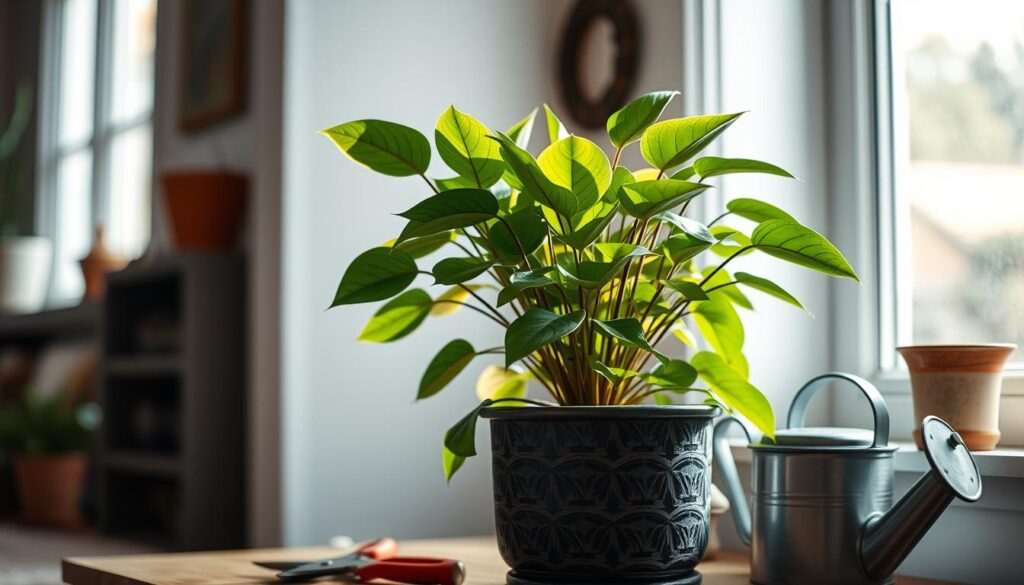
Seasonal Care Practices for Aspidistra
Seasonal care practices, such as reducing watering in the winter months when the plant is dormant, can also contribute to the overall health and longevity of your Aspidistra. Here are some tips to keep in mind:
- Water your Aspidistra sparingly during the winter months
- Provide plenty of indirect sunlight during the spring and summer months
- Fertilize your Aspidistra during the growing season to promote healthy growth
Troubleshooting Common Aspidistra Issues
Aspidistra, also known as Cast Iron Plant, is a hardy and low-maintenance houseplant. However, like any plant, it can still encounter issues. Troubleshooting Aspidistra problems requires identifying the cause and applying the right solution. Common issues with Cast Iron Plant include yellowing leaves and leaf spot diseases.
These problems can be caused by overwatering, underwatering, or exposure to direct sunlight. To address these issues, it’s essential to understand the causes and take corrective action. Here are some common problems and their solutions:
Yellowing Leaves: Causes and Solutions
- Overwatering: Check the soil moisture and adjust the watering schedule.
- Underwatering: Increase the frequency of watering, but make sure not to overwater.
- Direct sunlight: Move the plant to a spot with indirect sunlight.
Leaf Spot Problems and How to Fix Them
Leaf spot diseases can be treated with fungicides and by improving air circulation around the plant. It’s crucial to identify the cause of the problem and apply the appropriate solution to rescue your Aspidistra and prevent future issues.
By being aware of these common problems and how to troubleshoot them, you can become a more confident and capable plant parent. Remember to monitor your plant’s condition regularly and take action promptly if you notice any issues with your Cast Iron Plant.
| Issue | Cause | Solution |
|---|---|---|
| Yellowing leaves | Overwatering, underwatering, direct sunlight | Adjust watering schedule, move to indirect sunlight |
| Leaf spot diseases | Fungal infections | Treat with fungicides, improve air circulation |
Conclusion: Enjoy Your Indestructible Houseplant
As you’ve learned, caring for an Aspidistra, or Cast Iron Plant, is a remarkably simple and rewarding experience. This hardy houseplant is truly a resilient companion that can thrive even in the face of occasional neglect. By following the Aspidistra care tips outlined in this guide, you’ll be well on your way to cultivating a lush and vibrant hardy houseplant for your home.
Remember, the key to successful Aspidistra care is adaptability and a willingness to experiment. Pay close attention to your plant’s needs, and don’t be afraid to adjust your watering, lighting, or fertilization routines to find what works best. With a little patience and a nurturing touch, your Cast Iron Plant can provide years of low-maintenance beauty and air-purifying benefits.
So, embrace the resilience of the Aspidistra and embark on your journey to becoming a master of this versatile houseplant. Your indestructible companion is ready to add a touch of lush green ambiance to your living space. Enjoy the process of caring for your Aspidistra, and let it inspire you to explore the wonders of other hardy, low-maintenance plants that can thrive in your home.


